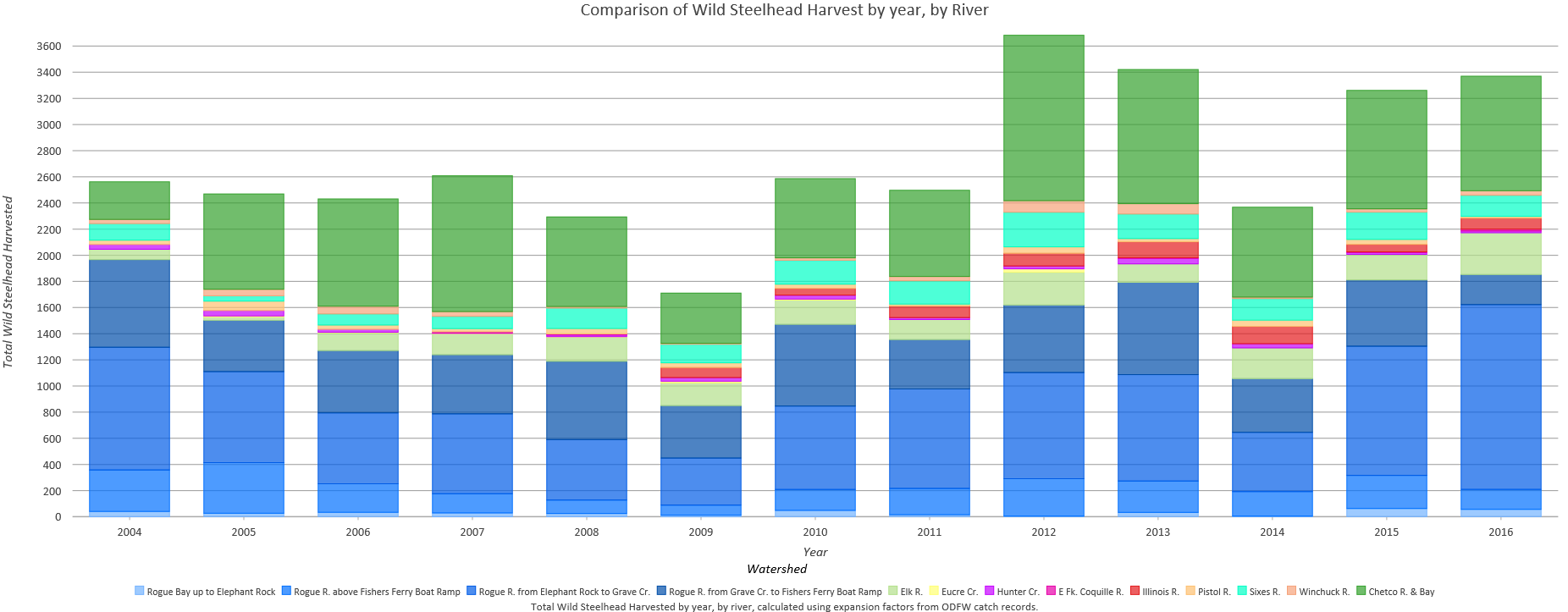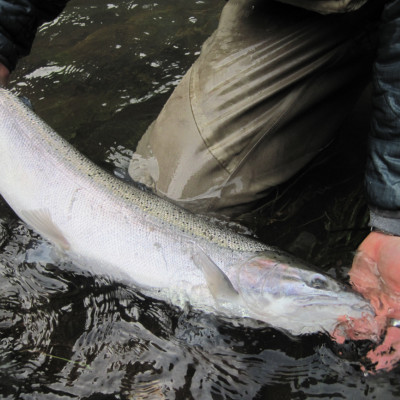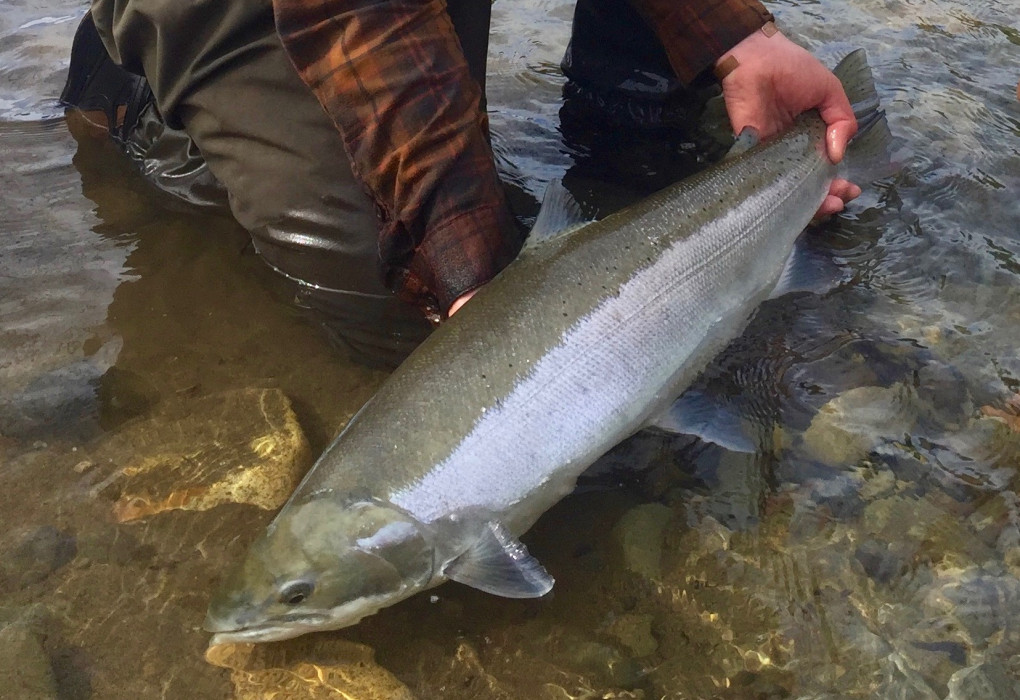Building a coalition for a sustainable wild steelhead fishery in southwest Oregon
Across their native range, there are twelve rivers in the lower 48 states and Canada where sport anglers can still legally harvest wild steelhead. All twelve of these rivers are in Oregon, and ten of those rivers are in the Southwest Zone. Legally, sport anglers can harvest wild steelhead in the East Fork Coquille, Illinois, Chetco, Elk, Pistol, Rogue, Sixes, and Winchuck rivers and Hunter and Euchre creeks. In Oregon, six Distinct Population Segments for steelhead have been identified, and four of those are listed under the federal Endangered Species Act because populations have crashed warranting protection by federal law.
Concerned about the health of wild steelhead in southwest Oregon, earlier this year a small group of longtime southwest Oregon guides and anglers lead by Harvey Young of Fishawk River Co. collected handwritten signatures to petition the Oregon Department of Fish and Wildlife to require the release of all wild steelhead in the Southwest Zone.
Their petition (available here on the ODFW website) cited numerous reasons why catch and release for wild steelhead would benefit anglers and businesses in southwest Oregon, but the main points were grounded in the fact there is not a good understanding of the status and trends of wild steelhead in southwest Oregon.
First, for the majority of rivers (8 out of 10) where wild steelhead harvest is still allowed in the SW zone, ODFW has no management plan, and monitoring has been dramatically reduced due to inadequate funding and increased demands elsewhere in the state. The East Fork Coquille and Sixes rivers are managed under the Coastal Multi-Species Conservation and Management Plan, which was adopted by the Commission in 2015.
Second, in the absence of good empirical data and adequate funding for monitoring, fisheries managers across the Northwest have implemented catch and release regulations that has proven to be an effective management tool that still provides fishing opportunity for sport anglers. For instance, catch and release regulations for wild steelhead are already in place for almost every river in Oregon outside the Southwest Zone (except the Salmon River and Big Elk Creek) and have existed in British Columbia, and Idaho since the 1980s, in California since 2010, and in Washington since 2015. In SE Alaska, in an effort to protect the resource, the department went to a 36" minimum limit for anglers to harvest any steelhead, which they believe protects more than 95% of the population from harvest.
In short, implementing catch and release regulations for wild steelhead in the Southwest Zone would be the most cost-effective, equitable, and easy to implement management action to protect these important world-class populations from over harvest.
When Harvey reached out asking for support, we connected him with River Stewards in the area to get an understanding of what level of impact they were witnessing in their homewaters. We all agreed. Sport fishing is the lifeblood of southwest Oregon, and in absence of a management plan and adequate funding for monitoring it was in the best interest to take a precautionary approach to protect these iconic wild fish, while still providing fishing opportunity.
We joined Harvey and shared the petition with other anglers, guides, and businesses that benefit from a healthy wild steelhead economy in southwest Oregon. After nearly 6 months of gathering signatures, Harvey and his crew were able to collect a total of 655 hand written signatures; 71% of those signatures are local anglers and the rest were anglers who had traveled to the area to fish.
This past July, the petition was submitted to the department and the issue was placed on the Oregon Fish and Wildlife Commission for their September meeting to be considered as part of the ongoing “simplification” process for salmon and steelhead sportfishing regulations.
Leading up to the Commission meeting, we dug into ODFW’s own data and reports. Through this review, we discovered:
- No spawning surveys have been conducted in the Rogue Management Area since 2009 due to budget constraints, and steelhead monitoring in the South Coast Monitoring Area has not been conducted since 2015 (ODFW, Jacobson et al., 2015).
- In 2015, estimates for adult wild steelhead spawners from the Klamath Mountain Province (the Elk River – South) were the lowest recorded since monitoring began in 2003 (ODFW, Jacobson et al., 2015).
- Steelhead spawning survey effort has been dramatically reduced on the Oregon Coast since 2008 due to budget constraints (ODFW, Jacobson, et al., 2015).
- Surveys conducted in 2017 showed less than 50% for both the 5 and 10 year average, and wild winter steelhead redds on the Mid Coast and Umpqua Management Area were below average since monitoring began in 2003 (ODFW, Jacobson et al., 2015).
- Juvenile abundance over the Klamath Mountains Province has generally declined over time, ranging from a high of approximately 131,000 fish in 2002, and dipping to a low of approximately 46,000 in 2015 (ODFW, Jacobson et al., 2017).
- Harvest of wild steelhead on the Elk River has increased approximately 1200% from 2005 – 2016, and between 2005 and 2012 the Sixes River experienced a 650% increase in wild steelhead harvest (ODFW unpublished data, obtained through a public records request).
- Wild steelhead harvest from 2002 - 2016 has definitely increased; from around 1600-2400 wild steelhead harvested to approximately 2200-3400 fish harvested per year (ODFW unpublished data, obtained through a public records request).

In September, NFS River Stewards and staff joined Harvey Young, and a collection of non-profits and businesses, including Fly Water Travel and Gold River Lodge, that submitted written and oral testimony in favor of catch and release regulations for wild steelhead in the Southwest Zone to the Oregon Fish and Wildlife Commission. Leading up to the Commission meeting, Harvey added another 3,000 electronic signatures through a change.org petition to the growing list of supporters for catch and release regulations.
Despite ODFW’s own data showing decline in wild steelhead spawners and a reduction in juvenile densities across the region, the department argued that there is no conservation concern for wild steelhead in the Southwest Zone. In turn, the department requested the Commission deny the petition and direct staff to develop a multi-species Conservation and Management Plan for the South Coast.
After hearing testimony on both sides, ultimately the Commission decided to lower the annual harvest limit of wild steelhead, from ‘one wild steelhead per day, five per year’ – to ‘one wild steelhead per day, three per year’; and directed ODFW staff to begin developing a South Coast Multi-species Conservation and Management Plan in Fall of 2019.
We remain concerned about the current framework for managing wild steelhead in southwest Oregon, but are grateful for the Commission’s leadership in lowering the annual harvest limits and initiating the department’s development of a management plan. While we didn’t get the clean sweep on the proposal, the Commissioners took the concerns that were raised and asked good questions of the department.
In the coming months, we need your voices on this issue more than ever. We will need the support of anglers of all types, no matter how you fish, guides, fishing clubs, local businesses, and elected officials.
How you can help:
- Please sign and share this online petition.
- Ask your city council, local fishing shop, and fishing club to write a letter in support of wild steelhead release and send them to Native Fish Society, 813 7th St. Suite 200A, Oregon City, OR 97045.
- If you own a business that depends on wild steelhead, write a business letter in support of wild steelhead catch and release and send them to Native Fish Society, 813 7th St. Suite 200A, Oregon City, OR 97045.
- Stay tuned for presentations and events this winter in SW Oregon. Contact jake@nativefishsociety.org to schedule a presentation in your area.
- Put a wild steelhead catch and release sticker on your truck (coming soon).
See below for our comments submitted to the Oregon Fish and Wildlife Commission:


